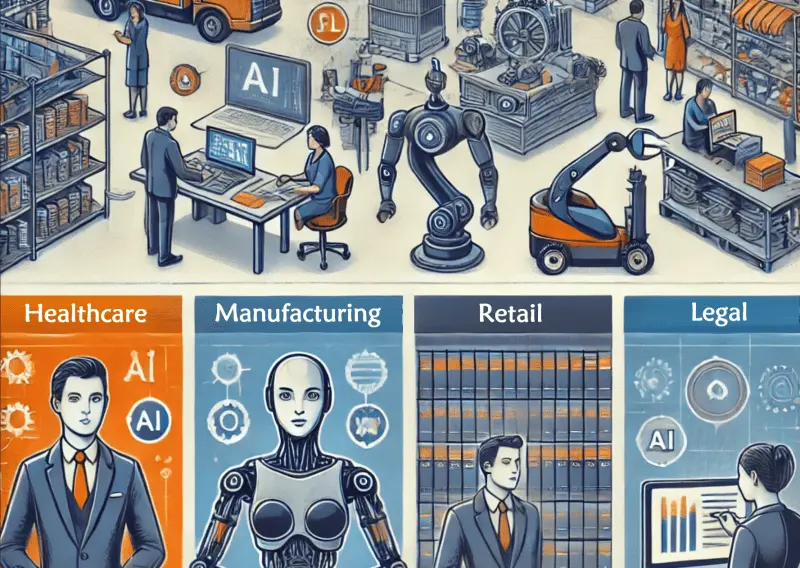Maroochydore
Call for Appointment
8:30am – 5:00pm Monday to Friday
Contact Sales
Maroochydore
Call for Appointment
8:30am – 5:00pm Monday to Friday
Contact Sales
As the business landscape evolves, automation has emerged as a powerful tool, transforming how companies operate and compete. The integration of automation in the workplace is no longer a distant future but a present reality, driving significant changes across various sectors. This shift towards automation is not just about adopting new technologies but about rethinking how businesses manage their processes, workforce, and resources.
Automation refers to the use of technology to perform tasks that previously required human intervention. This includes everything from simple data entry to complex decision-making processes. The adoption of automation in the workplace is driven by the need to improve efficiency, reduce errors, and cut costs. According to a study by McKinsey, automation could increase global productivity growth by 0.8 to 1.4 percent annually. This highlights the substantial impact automation can have on business operations and overall economic performance.
One of the most significant benefits of automation is its ability to handle repetitive tasks. These are tasks that are often mundane and time-consuming for employees but crucial for the smooth operation of a business. By automating these processes, companies can free up their employees to focus on more strategic and value-added activities. This not only improves employee satisfaction and engagement but also enhances the overall productivity of the organisation.
Implementing automation can lead to considerable cost savings for businesses. By reducing the need for manual labour, companies can lower their operational costs. For instance, automated data entry can minimise errors that often lead to costly corrections and rework. Additionally, automation can streamline processes, reducing the time and resources required to complete tasks. This efficiency translates into direct cost savings.
A report by Deloitte found that organisations implementing intelligent automation in their operations could see a return on investment (ROI) within just 12 months. This rapid payback period is due to the immediate reduction in operational costs and the increased efficiency gained from automation. Moreover, automation enables businesses to scale their operations without a corresponding increase in costs, making it a crucial strategy for growth. Explore our tailored software solutions for even greater efficiency gains and cost savings.
As automation continues to evolve, it is reshaping the future of work. The integration of advanced technologies like artificial intelligence (AI) and machine learning (ML) is pushing the boundaries of what automation can achieve. These technologies enable automation systems to learn from data, make predictions, and even perform complex decision-making tasks. This capability is transforming how businesses approach problem-solving and decision-making.
One notable trend is the rise of collaborative robots, or cobots, which are designed to work alongside human workers. Cobots can handle repetitive tasks while allowing human employees to focus on more complex and creative activities. This collaboration between humans and machines is creating a more dynamic and flexible workforce, capable of adapting to changing business needs.
Another emerging trend is the increasing use of automation in knowledge-based tasks. Traditionally, automation has been associated with manufacturing and production. However, advancements in AI and ML are enabling automation to penetrate fields such as finance, healthcare, and legal services. For example, AI-powered algorithms can analyse large volumes of data to identify patterns and insights that would be impossible for humans to detect manually. This capability is revolutionising industries by providing more accurate and timely information for decision-making.

Business process automation (BPA) involves using technology to automate complex business processes and workflows. BPA goes beyond simple task automation by integrating various systems and applications to streamline entire processes. This holistic approach ensures that all components of a process are optimised, resulting in greater efficiency and effectiveness.
For example, in the financial sector, BPA can automate the entire accounts payable process, from invoice receipt to payment. This includes validating invoices, matching them with purchase orders, and processing payments. By automating these steps, companies can significantly reduce the time and effort required to manage their accounts payable, leading to faster processing times and improved cash flow management.
BPA also plays a critical role in improving compliance and reducing risk. Automated processes are consistent and repeatable, which helps ensure that all tasks are performed according to established procedures and regulatory requirements. This consistency reduces the risk of errors and non-compliance, which can result in costly fines and reputational damage. Discover our custom BPA solutions that integrate seamlessly with your existing systems.
The benefits of automation for businesses are multifaceted, extending beyond cost savings and efficiency gains. Automation enables companies to improve the accuracy and quality of their operations, leading to better customer satisfaction and loyalty. For example, automated customer service systems can provide faster and more accurate responses to customer inquiries, enhancing the overall customer experience.
Additionally, automation can drive innovation by freeing up resources that can be redirected towards research and development (R&D) and other strategic initiatives. Companies that embrace automation are better positioned to innovate and stay ahead of the competition. This innovation is crucial in today’s fast-paced business environment, where the ability to adapt and evolve is a key determinant of success.
Automation also supports better decision-making by providing real-time data and insights. Automated systems can collect and analyse vast amounts of data, providing businesses with valuable information that can inform strategic decisions. This data-driven approach enables companies to make more informed decisions, leading to better outcomes and increased competitiveness.
One of the primary motivations for adopting automation is the potential for reducing operational costs. Automation eliminates the need for manual intervention in repetitive tasks, which reduces labour costs and minimises the risk of human error. This cost reduction is particularly significant in industries with high labour costs or where precision and accuracy are critical.
For example, in the manufacturing sector, automation can reduce the need for manual assembly and inspection, leading to lower production costs and higher quality products. Similarly, in the healthcare industry, automation can streamline administrative tasks, such as patient registration and billing, reducing the burden on healthcare providers and allowing them to focus on patient care.
Efficiency is a critical factor in the success of any business. Automation enhances efficiency by optimising processes and eliminating bottlenecks. Automated systems can perform tasks faster and more accurately than humans, leading to shorter cycle times and higher throughput. This increased efficiency translates into faster delivery times and improved customer satisfaction.
Moreover, automation enables businesses to operate around the clock, without the limitations of human work schedules. This 24/7 capability ensures that processes continue to run smoothly, even outside of regular business hours. For example, automated customer service systems can handle inquiries and support requests at any time, providing customers with timely assistance and improving their overall experience. Learn how our development team can enhance your business efficiency with automation-focused software.

Implementing automation requires careful planning and a strategic approach. Businesses need to identify the processes that are most suitable for automation and evaluate the potential benefits and costs. This involves conducting a thorough analysis of existing processes, identifying inefficiencies, and determining the feasibility of automation.
One effective strategy is to start with small-scale automation projects that can deliver quick wins. These projects can serve as proof of concept and demonstrate the value of automation to stakeholders. Once the benefits are realised, businesses can gradually expand their automation efforts to more complex and critical processes.
It’s also essential to involve employees in the automation journey. Providing training and support can help employees adapt to the changes and embrace automation as a tool that enhances their work rather than replaces them. This collaborative approach fosters a positive culture around automation and ensures its successful implementation.
Productivity is a key driver of business success, and automation plays a crucial role in enhancing productivity. By automating repetitive and time-consuming tasks, businesses can free up their employees to focus on higher-value activities. This not only increases the productivity of individual employees but also enhances the overall productivity of the organisation.
For example, in the retail sector, automation can streamline inventory management, ensuring that products are always in stock and reducing the time spent on manual inventory checks. This allows employees to focus on customer service and sales, driving higher revenue and profitability.
Additionally, automation can improve the accuracy and consistency of tasks, reducing the need for rework and corrections. This consistency ensures that processes are executed correctly every time, leading to higher quality outcomes and improved customer satisfaction.
Technology is a powerful enabler of cost reduction in businesses. By leveraging advanced technologies such as AI, ML, and robotic process automation (RPA), companies can automate complex tasks and processes that were previously difficult to automate. These technologies can analyse data, make decisions, and perform actions with minimal human intervention, leading to significant cost savings.
For example, AI-powered chatbots can handle customer inquiries and support requests, reducing the need for human customer service representatives. This not only lowers labour costs but also ensures that customers receive prompt and accurate responses.
Similarly, RPA can automate routine administrative tasks, such as data entry and report generation, reducing the time and effort required to perform these tasks. This enables businesses to operate more efficiently and focus their resources on strategic initiatives that drive growth and innovation.
Several key technologies are at the forefront of the automation revolution, each contributing to the transformation of business operations in unique ways. Among these, Artificial Intelligence (AI), Machine Learning (ML), and Robotic Process Automation (RPA) stand out as the most influential.
Artificial Intelligence and Machine Learning AI and ML are transforming how businesses operate by enabling systems to learn from data and make informed decisions. These technologies can analyse vast amounts of data, identify patterns, and make predictions with a high degree of accuracy. For example, AI algorithms can analyse customer data to predict purchasing behaviours, allowing businesses to tailor their marketing strategies accordingly.
AI and ML also enhance automation by enabling systems to adapt to changing conditions and improve over time. For instance, AI-powered chatbots can provide more accurate and personalised responses to customer inquiries as they learn from past interactions. This capability not only improves customer service but also reduces the workload on human employees, allowing them to focus on more complex tasks.

RPA involves using software robots to automate repetitive tasks that are rule-based and require minimal human judgment. RPA is particularly useful for tasks such as data entry, invoice processing, and report generation. By automating these tasks, businesses can significantly reduce the time and effort required to complete them, leading to increased efficiency and cost savings.
One notable example of RPA in action is its use in the financial sector. Financial institutions often deal with large volumes of data that need to be processed quickly and accurately. RPA can automate tasks such as transaction processing, compliance checks, and customer onboarding, enabling financial institutions to operate more efficiently and reduce the risk of errors. As mentioned in a blog post on Medium, companies implementing RPA have seen a 20-30% increase in efficiency and a reduction in operational costs by up to 50%.
The impact of automation extends across various industries, each reaping unique benefits from the integration of these advanced technologies.
Automation is revolutionising the healthcare industry by streamlining administrative tasks and improving patient care. For example, automated systems can handle patient registration, appointment scheduling, and billing, reducing the administrative burden on healthcare providers and allowing them to focus more on patient care. AI-powered diagnostic tools can also assist doctors in identifying diseases and conditions more accurately and at an earlier stage, improving patient outcomes. According to a McKinsey report, this integration of AI and automation has the potential to transform healthcare by improving both efficiency and quality of care.
In the manufacturing sector, automation is enhancing production efficiency and product quality. Automated assembly lines, powered by robotics, can operate 24/7, increasing production capacity and reducing downtime. Additionally, AI and ML can optimise supply chain management by predicting demand and managing inventory levels, ensuring that manufacturing processes run smoothly and efficiently.
Retailers are leveraging automation to improve inventory management, enhance customer service, and streamline operations. For instance, AI algorithms can analyse sales data to predict inventory needs, reducing the risk of stockouts and overstocking. Automated checkout systems and chatbots enhance the customer experience by providing quick and efficient service, leading to higher customer satisfaction and loyalty.
In the legal industry, automation is being used to streamline document review and contract management. AI-powered tools can analyse legal documents, identify key terms and clauses, and flag potential issues, reducing the time and effort required for manual review. This not only improves efficiency but also reduces the risk of errors and ensures compliance with legal standards.

Implementing automation within a business is a multifaceted process that requires careful planning, strategic decision-making, and ongoing management. Here, we explore key strategies and best practices to ensure a successful automation journey.
The first step in implementing automation is to identify the processes that will benefit the most from automation. This involves conducting a thorough analysis of current workflows to pinpoint inefficiencies and areas where automation can have the greatest impact. Processes that are repetitive, time-consuming, and prone to human error are prime candidates for automation.
For example, in the finance department, tasks such as invoice processing, expense reporting, and financial reconciliations are often repetitive and labour-intensive. Automating these processes can lead to significant time and cost savings, while also improving accuracy and compliance. Similarly, in customer service, automating routine inquiries with AI-powered chatbots can enhance response times and customer satisfaction.
A clear and well-defined automation strategy is crucial for successful implementation. This strategy should outline the goals and objectives of automation, the processes to be automated, and the expected benefits. It should also include a roadmap for implementation, detailing the steps involved, timelines, and resources required.
Engaging stakeholders from across the organisation is essential to ensure buy-in and support for the automation initiative. This includes senior leadership, IT, and employees who will be affected by the changes. Communicating the benefits of automation, such as improved efficiency, cost savings, and enhanced job satisfaction, can help build a positive perception and foster a collaborative approach.
Choosing the right technology is critical to the success of an automation project. Businesses should evaluate different automation tools and platforms based on their capabilities, scalability, and ease of integration with existing systems. It is important to select technologies that align with the organisation’s specific needs and long-term goals.
For instance, RPA tools are ideal for automating rule-based tasks, while AI and ML are better suited for tasks that require data analysis and decision-making. Back in 2020, Gartner estimated that by 2022, 85% of large organisations would have deployed some form of RPA, underscoring the growing adoption of this technology across industries. Companies should also consider the support and training provided by technology vendors to ensure a smooth implementation and ongoing maintenance.
Before rolling out automation across the entire organisation, it is advisable to conduct pilot tests on a smaller scale. Pilot testing allows businesses to evaluate the effectiveness of the automation solution, identify any issues, and make necessary adjustments. This iterative approach helps to refine the automation process and ensures that it delivers the desired outcomes.
During the pilot phase, it is important to collect feedback from users and monitor the performance of the automated processes. Metrics such as time savings, error reduction, and user satisfaction can provide valuable insights into the success of the pilot and areas for improvement.
Automation is not a one-time project but an ongoing journey. Continuous monitoring and optimisation are essential to ensure that automated processes remain efficient and effective. Regularly reviewing and updating automation solutions can help address any changes in business requirements and incorporate new technologies and best practices.
Businesses should establish key performance indicators (KPIs) to track the performance of automated processes and measure the impact on business goals. By continuously monitoring these KPIs, organisations can identify areas for further optimisation and ensure that they are maximising the benefits of automation.

While automation offers numerous benefits, its implementation is not without challenges. Businesses must navigate these challenges carefully to ensure a smooth transition and successful integration of automated processes.
One of the most significant challenges businesses face when implementing automation is resistance to change from employees. This resistance often stems from fear of job loss or apprehension about adapting to new technologies. To address this, it is crucial to involve employees early in the automation process and communicate the benefits clearly. Emphasising that automation is intended to enhance their roles rather than replace them can help alleviate concerns.
Providing adequate training and support is also essential. Employees should be given the opportunity to learn about the new technologies and understand how they can improve their daily tasks. According to a report by McKinsey, companies that invest in upskilling their workforce alongside automation initiatives are more likely to see higher levels of employee engagement and acceptance.
Automation often involves handling large volumes of data, including sensitive information. Ensuring the security and privacy of this data is paramount. Businesses must implement robust security measures to protect against data breaches and ensure compliance with regulations such as the General Data Protection Regulation (GDPR).
Selecting automation tools and platforms with strong security features is critical. This includes encryption, access controls, and regular security audits. Additionally, businesses should establish clear data governance policies and procedures to manage and protect data effectively.
Integrating automation solutions with existing systems and processes can be complex. Legacy systems may not always be compatible with new automation technologies, leading to integration challenges. To overcome this, businesses should conduct a thorough assessment of their current IT infrastructure and identify any potential compatibility issues.
Working with experienced vendors and consultants can also facilitate the integration process. These experts can provide guidance on selecting the right tools and technologies that seamlessly integrate with existing systems. According to a study by Forrester companies that engage with external consultants for their automation projects are more likely to achieve successful integration and realise the benefits of automation faster.
While automation can lead to significant cost savings in the long run, the initial investment can be substantial. Businesses need to carefully manage these costs and ensure a clear understanding of the expected return on investment (ROI). This involves developing a detailed business case that outlines the costs, benefits, and payback period of the automation project.
Conducting pilot tests and small-scale implementations can help businesses validate their assumptions and demonstrate the value of automation before committing to larger investments. By closely monitoring the performance of pilot projects and analysing the results, companies can make informed decisions about scaling up their automation efforts.
Automation is not a one-time initiative but an ongoing process that requires continuous improvement and adaptation. As business needs evolve and new technologies emerge, companies must regularly review and update their automation strategies. This includes staying informed about industry trends, advancements in automation technology, and changes in regulatory requirements.
Establishing a culture of continuous improvement and innovation is crucial for the long-term success of automation initiatives. Businesses should encourage employees to provide feedback and suggest improvements to automated processes. This collaborative approach ensures that automation remains aligned with business goals and continues to deliver value over time.
To illustrate the transformative power of automation, let’s examine a few case studies of businesses that have successfully implemented automation, highlighting the benefits they achieved, and the lessons learned from their experiences.
A major financial services company implemented Robotic Process Automation (RPA) to streamline its accounts payable process. Previously, the process involved multiple manual steps, including invoice receipt, validation, approval, and payment. This was not only time-consuming but also prone to errors.
By automating the entire accounts payable process, the company was able to reduce processing time by 60% and cut operational costs by 40%. The automation solution also improved accuracy, virtually eliminating errors that previously led to costly rework. According to a report by Deloitte, the implementation of RPA provided a return on investment within 12 months, underscoring the financial benefits of automation.
In the healthcare sector, a large hospital network adopted AI-powered automation to enhance patient care and streamline administrative tasks. The hospital implemented automated systems for patient registration, appointment scheduling, and billing. Additionally, AI algorithms were used to analyse patient data and provide decision support for doctors.
The result was a significant improvement in operational efficiency and patient satisfaction. Administrative tasks that previously took hours to complete were now done in minutes, freeing up healthcare providers to focus on patient care. The use of AI for diagnostic support also led to more accurate diagnoses and better patient outcomes. According to a McKinsey report, this integration of AI and automation has the potential to transform healthcare by improving both efficiency and quality of care.
A leading manufacturing company implemented automation to enhance its production processes and supply chain management. The company deployed robotic arms for assembly tasks and AI algorithms for inventory management. This automation initiative allowed the company to operate its assembly lines 24/7, increasing production capacity and reducing downtime.
The AI-driven inventory management system optimised stock levels, ensuring that materials were always available when needed and reducing the risk of overstocking. This not only improved production efficiency but also resulted in substantial cost savings. As a result, the company saw a 30% increase in production efficiency and a 20% reduction in inventory costs. This case highlights how automation can drive significant improvements in both operational efficiency and cost management.

The future of work is undoubtedly being shaped by automation. By leveraging automation for cost savings, businesses can improve accuracy, reduce operational costs, and enhance productivity. The key to successful automation lies in strategic planning, careful implementation, and continuous improvement. By identifying the right opportunities, selecting suitable technologies, and involving employees in the process, businesses can overcome challenges and realise the full benefits of automation.
Automation is not just about replacing human labour; it is about augmenting human capabilities and enabling employees to focus on more meaningful and strategic tasks. As demonstrated by the case studies, automation can drive substantial improvements in efficiency, accuracy, and cost savings across various industries. By embracing automation, businesses can position themselves for long-term success in an increasingly competitive and dynamic market.
For more insights and practical advice on automation, consider exploring resources from industry experts such as Deloitte’s report on RPA implementation and McKinsey’s research on AI in healthcare. These references provide valuable information and case studies that can guide businesses on their automation journey.
In conclusion, the future of work with automation is bright, promising significant benefits for businesses willing to embrace change and innovate. By leveraging technology strategically, companies can enhance their operations, drive cost savings, and ensure sustainable growth in the years to come.
Copyright Absolute IT. All Rights Reserved.